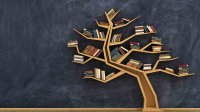A Reading List for Differentiated Instruction
You can find ideas on how to gear your teaching to meet the needs of all students even in works that aren’t explicitly about differentiation.
One of the many hopes that we as educators have for our students is that they become lifelong learners. We want them to explore their passions, which in time might turn into career opportunities. Through conversations, books, and media, we plant ideas that may someday grow into something useful in a student’s life journey.
I often refer to the stories told by Steve Jobs in his 2005 commencement speech to Stanford University graduates as an example of a lifelong learning journey. Jobs discussed how following his “curiosity and intuition” led to “connecting the dots” of self-exploration, which led to professional opportunities and success.
Jobs’s words in that speech inspired over 27 million views. Through practicing lifelong learning, we can connect the dots with learners and model how they can accomplish much by following their curiosity and intuition.
Meeting the needs of all learners does not have to be difficult. Any instructional practice or system we explore that attends to student voice and agency can be personalized to individuals and groups—which is differentiation. I’ve written a book on differentiation, So All Can Learn, but you can get ideas on the topic from all sorts of sources. To that end, here are readings that encourage reflection and conversation about effective practices that we might include in our toolbox.
“Free Is Good”
This article by Bethany Rayl is packed with ideas for accessing open educational resources (OER). Use it to differentiate by flipping its ideas and showing students how they can revise, remix, and redistribute content, sharing their voice with a public audience. Use the wealth of materials to personalize activities for individuals or groups in order to meet the needs of your learners.
Classroom Instruction That Works: Research-Based Strategies for Increasing Student Achievement
This classic book by Ceri B. Dean, Elizabeth Ross Hubbell, Howard Pitler, and Bj Stone covers nine practices that can provide high yields in learning. All of them can be differentiated by simply giving students options so they can make their own choices. Here are examples for differentiating each practice.
Developing Natural Curiosity Through Project-Based Learning: Five Strategies for the PreK–3 Classroom
With this book by Dayna Laur and Jill Ackers, explore how young kids can do project-based learning (PBL) with strong authentic experiences beyond the traditional classroom. For example, the authors’ take on unpacking standards into powerful learning experiences is gold. Relating curriculum to students’ lives leads to differentiation connections by fostering voice and choice—key elements in PBL—and helps learners see relevance and purpose in assignments.
The Space: A Guide for Educators
Rethinking and reimagining classroom space setups can develop a culture of learning if we include students in the shaping of the environment. Student voice is a powerful differentiation tool. This accessible book by Rebecca Hare and Robert Dillon provides a thoughtful way to rethink classroom space based on what students determine is valuable to their learning experiences.
Creating Cultures of Thinking: The 8 Forces We Must Master to Truly Transform Our Schools
Be prepared to be challenged by what students need versus what is comfortable for adults. The ideas in this book by Ron Ritchhart, backed by powerful examples, will challenge most educators about what we know is best for students, and our perceptions of what can be done. If you believe that students should be at the center of all decisions, use this book to become an innovator of a can-do philosophy.
Visible Learning and the Science of How We Learn
This treasure trove of research-backed ideas by John Hattie and Gregory Yates will challenge cherished practices and inspire permission to expand one’s teacher toolbox to meet each student’s needs. The chapter “The Role of Feedback” alone makes this book a necessary read if we are to help all students achieve.
Breathing In, Breathing Out: Keeping a Writer’s Notebook
Joy Write: Cultivating High-Impact, Low-Stakes Writing
What a Writer Needs
Ralph Fletcher is an essential mentor for all who teach writing. It’s hard to choose just one of his books, so here are three that help teachers understand the perspective of students, who typically do not view themselves as writers. Teachers can address the needs of diverse learners by using Fletcher’s concrete ways to transform fearful students into confident writers.
As Yoda says, “Do. Or do not. There is no try.” Being a lifelong learner requires perseverance and a willingness to be vulnerable with oneself. Choose a couple of these suggested readings. Find affirmation of what you already know is important, and explore ideas that might shift your thinking. Reflect with honest self-assessment on the weaknesses in your practice—we all have them. No apologies need be offered for being a flawed human being. So long as we strive and struggle to become better than our past self, there is renewed hope.
